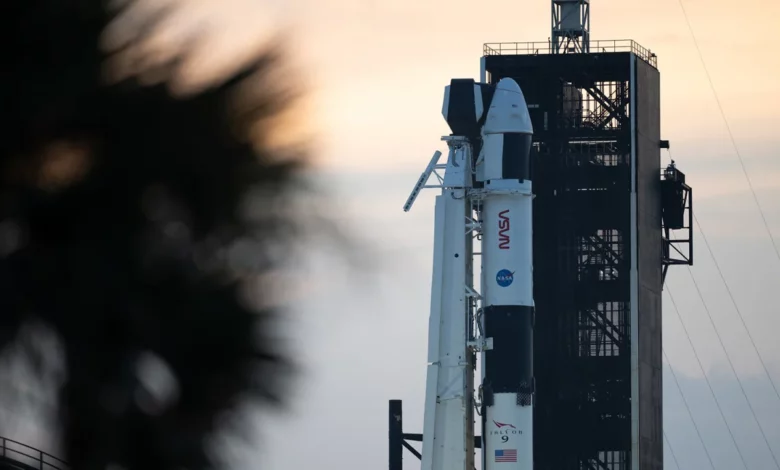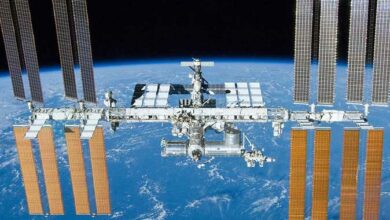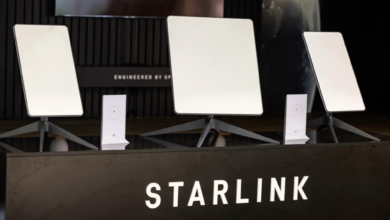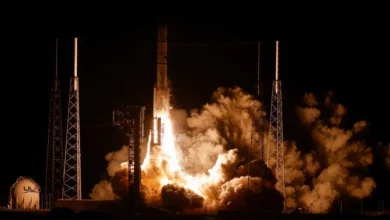
The crew will ride aboard the SpaceX Crew Dragon Endurance capsule on the mission, dubbed Crew-7, that will be jointly overseen by NASA and SpaceX en route to the space station. Liftoff of the capsule, which will launch atop a SpaceX Falcon 9 rocket from NASA’s Kennedy Space Center in Florida, is expected at 3:27 a.m. ET Saturday.
The latest forecasts from the launch site give a 95 percent chance that weather will be clear enough for takeoff.
NASA and SpaceX had been targeting an early Friday morning liftoff, but on Thursday night, officials abruptly waved off the launch attempt. NASA revealed in a blog post that the 24-hour delay was meant to allow engineers more time to “reconfirm required factors of safety” on the Crew Dragon spacecraft’s life support systems.
The four astronauts on the Crew-7 include NASA’s Jasmin Moghbeli, who will be mission commander; Danish astronaut Andreas Mogensen representing the European Space Agency; Satoshi Furukawa of the Japan Aerospace Exploration Agency, or JAXA; and Russian cosmonaut Konstantin Borisov of Roscosmos.
After liftoff, the Crew Dragon capsule will detach from the Falcon 9 rocket, beginning its solo trek through orbit. The spacecraft will spend more than 24 hours carefully maneuvering toward the space station, which orbits about 220 nautical miles (420 kilometers) above Earth’s surface. The crew is expected to dock at the space station around 8:39 a.m. ET Sunday.
Once on board, Moghbeli, Mogensen, Furukawa and Borisov will join the seven astronauts already on the orbiting laboratory.
The Crew-7 astronauts will spend about five days taking over operations from the SpaceX Crew-6 astronauts, who have been on the space station since March.
About this mission
This mission marks the eighth flight operated by NASA and SpaceX as part of the agency’s commercial crew program, which has been ferrying astronauts to the space station since SpaceX’s first crewed mission in 2020.
The Crew-7 astronauts represent the most internationally diverse SpaceX crew to date.
“We are extremely proud — and I know I personally am humbled — to be a member of this incredible crew, where if you look at our four patches you’ll see a different nation’s flag on each one,” Moghbeli said during a news conference, conducted just after the crew arrived this past Sunday in Florida. The mission commander was referring to the flag patches adorning the left shoulder of the astronauts’ suits. “We hope this represents what we can accomplish when we work together in unity and cooperate together. And we think this really is what the International Space Station is all about.”
The crew also worked together to design its official mission patch, which includes a depiction of a dragon nestled atop the Earth.
“We wanted it to represent that everything we do on this mission, we hope ultimately benefits our beautiful home planet and those on it,” Moghbeli said, adding that the red, white and blue stripes on the dragon’s tail represent the colors that make up the flags for all four countries represented on the Crew-7 mission.
During their stay on the space station, which is expected to last about 190 days, the Crew-7 astronauts will pore through a slate of experiments. The research will include investigating the potential risk of dispersion of bacteria and fungi from human-led space missions. The team will analyze whether the microorganisms can be expelled from the space station’s vents and spewed into the vacuum of space.
Another project, from the ESA, will investigate how sleeping in the microgravity environment differs from Earth by analyzing astronauts’ brain waves while they doze off. Yet another experiment will look at the formation of biofilms in wastewater on the space station, which could be key to finding better ways to recycle water for drinking and hygiene while in space. (Yes, astronauts have long used recycled sweat and urine to drink and shower on the station.)
‘Life-changing perspective’
Commander Moghbeli was born in Bad Nauheim, Germany — near Frankfurt — to Iranian parents, but she considers Baldwin, New York, on Long Island her hometown.
After graduating high school, she earned her bachelor’s degree in aerospace engineering from the Massachusetts Institute of Technology before gaining a master’s in aerospace engineering from the Naval Postgraduate School in Monterey, California.
Moghbeli also has military experience under her belt, including serving as a Marine Corps test pilot and logging more than 150 combat missions and 2,000 hours of flight time.
She was selected to join NASA’s astronaut corps in 2017, and Crew-7 will mark her first foray into space.
“This is something I’ve wanted to do for as long as I can remember,” Moghbeli said during a July 25 news conference. “One of the things I’m most excited about is looking back at our beautiful planet. Everyone I’ve talked to who has flown already has said that was kind of a life-changing perspective.”
Russia’s role
Borisov will become the third cosmonaut with Russia’s space agency, Roscosmos, to fly on a US-made spacecraft as part of a seat-swapping agreement inked between NASA and Roscosmos in 2022.
Sharing rides to the space station has long been a tradition for NASA and Roscosmos, and the latter agency even was the sole transportation provider for years after NASA retired its space shuttle program in 2011. This latest rideshare deal, however, loomed large over NASA last year amid rising tensions between the United States and Russia over the ongoing war in Ukraine.
NASA has repeatedly said that tensions on the ground have had no effect on the countries’ ongoing cooperation in space.
Like Moghbeli, Borisov will be making his first flight to space.
“It’s so hard to imagine that soon we’ll just do similar things, but it won’t be training,” Borisov said Sunday.
“I’m very excited, really. I’m honored to be a part of the international crew,” he added. “Experienced astronauts and cosmonauts, they say that when you go to the ISS and you look at the planet, you see that there are no borders. And really, I want to convey that feeling and that emotion.”
SpaceX’s Crew Dragon and Russia’s Soyuz are currently the only vehicles capable of carrying astronauts to and from the space station, though NASA hopes to introduce another provider in the coming months. Boeing’s Starliner, which, like SpaceX, is under NASA’s commercial crew contracting program, is expected to enter operation within the next year after years of delays.
Rounding out the crew
Mogensen, who will be the Crew-7 mission pilot, is a Copenhagen native and obtained his bachelor’s degree from Copenhagen International School before earning a master’s in aeronautical engineering from Imperial College London in the United Kingdom. He also received a doctorate in aesrospace engineering from the University of Texas at Austin.
Before being selected for astronaut training by ESA in 2009, he was a research fellow at the Surrey Space Centre in the UK, where he studied navigation and control for spacecraft landing on the moon.
This mission will mark his second flight to space, following a flight on a 10-day Russian Soyuz mission to the space station in 2015.
“It’s hard to describe what an incredible place the International Space Station is,” Mogensen said at a Sunday news conference. “I didn’t realize it until shortly before docking on my first mission when I looked out the windows … and I could see the gigantic solar arrays stretching out in space next to me.
“I realized just what a unique and incredible laboratory that we — humanity — has built in low-Earth orbit over the past 20, 25 years.”
Furukawa, the only other spaceflight veteran among the Crew-7 astronauts, was born in Kanagawa, Japan, just south of Tokyo. He earned a medical degree and doctorate in medical science from the University of Tokyo before working as a clinical surgeon.
He was selected as a JAXA astronaut in 1999 and completed his first mission to the space station — a 165-day stay — in 2011 after launching aboard NASA’s final space shuttle mission, STS-135.
Furukawa said he looks forward to reinhabiting the microgravity environment on the space station and delving into scientific pursuits, including research that could aid the development of new medicine and projects that could help inform how humans can one day explore the moon.
After reaching the space station, the Crew-7 astronauts will bid farewell to the SpaceX Crew-6 astronauts, who will return home aboard their spacecraft, the Crew Dragon Endeavour, in the coming days.
In mid-September, the space station crew will also welcome NASA astronaut Loral O’Hara, along with cosmonauts Oleg Kononenko and Nikolai Chub, who will be launching aboard the Russian Soyuz MS-24 capsule.




